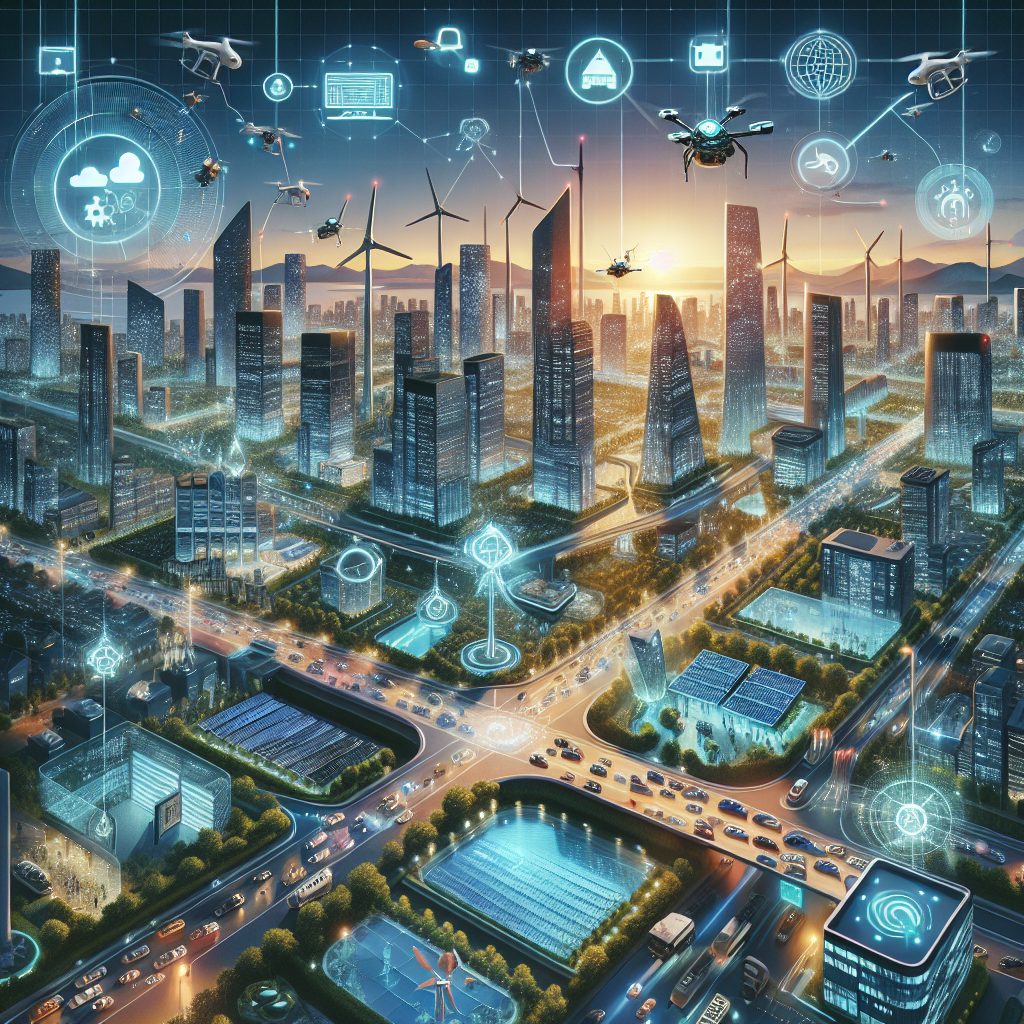As cities swell with populations soaring into the millions, investing in their future has never been more critical. The concept of Smart Cities harnesses technology to revitalize urban spaces, ensuring they’re sustainable and efficient. Imagine streets where traffic flows seamlessly thanks to real-time data, or energy systems that slash carbon footprints while keeping the lights on. This isn’t a sci-fi script; it’s the blueprint for our urban tomorrow.
Diving into this article, you’ll unravel the fabric of Smart Cities, exploring how clever investments are crafting communities that are not just livable but lively. You’ll discover how integrating IoT, AI, and big data is transforming concrete jungles into responsive ecosystems. It’s a journey through innovation, where every dollar spent is a step toward a future where city life hums with possibility. So buckle up; we’re about to take a ride into the heart of modern urbanity—where every street corner whispers the promise of a smarter world.
Important Highlights
1. Smart city investments focus on utilizing advanced technologies like the Internet of Things (IoT), artificial intelligence, and big data analytics to enhance urban infrastructure, transportation, public services, and resource management. These innovations aim to create more efficient and sustainable urban environments, ultimately improving the quality of life for residents.
2. A key driver in the smart cities movement is the need to tackle pressing urban challenges such as traffic congestion, air pollution, and energy consumption. Implementing smart traffic management systems and eco-friendly public transportation options are examples of how cities can become more livable while also addressing environmental concerns.
3. The economic benefits of investing in smart infrastructure are significant; they include job creation in tech-driven sectors and increased efficiency that can lead to cost savings for city administrations. Moreover, these advancements often attract businesses and investors looking for dynamic, connected environments conducive to innovation.
4. Public-private partnerships play a pivotal role in developing smart cities, as they facilitate funding and expertise sharing between government entities and technology companies. This collaborative approach is essential for large-scale projects that require substantial investment and specialized knowledge that may be beyond the scope of public finances alone.
5. Data security and privacy remain paramount as cities adopt these interconnected systems; robust cybersecurity measures must be integrated from the outset to protect sensitive information from potential breaches. Citizens’ trust in how their data is handled is crucial for the widespread acceptance of smart city solutions.
For further insights into how urban centers are evolving through technology, explore content from Smart Cities World, a leading authority on urban innovation.
Key Elements of Smart City Infrastructure
Smart cities leverage cutting-edge technology to enhance urban living. Core infrastructure components include high-speed broadband, IoT sensors, and data analytics platforms. These elements work together to optimize city services such as transportation, energy distribution, and public safety. By integrating smart traffic management systems, cities reduce congestion and improve air quality.
Investment in Sustainable Energy Solutions
To create a more sustainable urban future, smart cities invest heavily in green technologies. Solar panels, wind turbines, and smart grids are essential for reducing carbon footprints. Cities also explore innovative solutions like kinetic energy from pedestrian foot traffic or renewable energy initiatives.
The Role of Public-Private Partnerships
Public-private partnerships (PPPs) significantly contribute to the development of smart cities. These collaborations pool resources from both sectors to fund large-scale projects that might be financially unfeasible for governments alone. PPPs ensure the deployment of advanced technologies such as intelligent transportation systems, enhancing overall urban efficiency.
Fostering Digital Innovation Hubs
Digital innovation hubs serve as incubators for new technologies. These hubs attract startups and investors focused on urban tech solutions like waste management apps or water monitoring systems. They play a pivotal role in driving forward the vision of a connected city landscape.
Incorporating Artificial Intelligence
Artificial intelligence (AI) stands at the forefront of transforming urban areas into smart cities. AI applications range from predictive maintenance of infrastructure to AI-powered security cameras. By harnessing machine learning algorithms, cities predict traffic flows, enhance emergency response times, and personalize citizen interactions with government services.
Data Security and Privacy Concerns
As smart cities collect vast amounts of data, ensuring privacy and security is paramount. Investment in cybersecurity measures is non-negotiable to protect citizens’ information from breaches. Transparent data governance policies must guide how data is collected, stored, and used within smart city frameworks.
Mobility and Transportation Advances
Sustainable mobility is critical in smart city planning. Electric vehicles (EVs), bike-sharing programs, and autonomous vehicles are reshaping how people navigate urban spaces. Smart traffic lights improve flow while reducing emissions, exemplifying how technology serves environmental goals.
Economic Impacts of Smart City Technologies
The adoption of smart technologies fosters economic growth by creating jobs in tech fields and attracting businesses seeking efficiency and innovation. It also spurs advancements in ancillary services like logistics and supply chain management due to improved connectivity provided by IoT devices.
Citizen Engagement in Smart City Initiatives
Citizen participation is crucial for the success of any smart city initiative. Interactive platforms that solicit feedback on urban projects encourage community involvement. Such engagement ensures that investments align with residents’ needs, fostering an inclusive approach towards urban development.
Tackling Urban Challenges Through Technological Innovation
Solving complex urban challenges requires innovative thinking backed by technological prowess. Smart water management systems detect leaks to prevent waste, while intelligent lighting reduces energy consumption without compromising safety—each solution tailored to address specific urban issues effectively.
? What Are Some Practical Tips for Cities Looking to Invest in Smart Technology?
- Evaluate current infrastructure capabilities and identify key areas for improvement.
- Engage stakeholders early on to align goals across various sectors.
- Prioritize scalable solutions that can adapt to future technological advances.
- Implement robust cybersecurity strategies to protect citizen data.
- Create transparent policies regarding data usage and privacy concerns.
- Incorporate citizen feedback mechanisms into the development process.
- Benchmark against other successful smart cities to learn best practices.
- Leverage government incentives for sustainable technology investments.
- Promote digital literacy programs to ensure widespread adoption among residents.
- Maintain flexibility to pivot strategies based on emerging trends and innovations.
Frequently Asked Questions
What is a Smart City?
A smart city uses digital technology to boost performance and wellbeing, to reduce costs and resource consumption, and to engage more effectively with its citizens.
Why should we invest in Smart Cities?
Investing in smart cities promises enhanced urban life quality, efficient service delivery, and sustainable economic growth. It’s a step towards future-proof living environments.
How do Smart Cities improve everyday life?
They streamline urban operations like traffic management and public safety, leading to smoother commutes and safer neighborhoods. Plus, they provide real-time data for informed decision-making.
Can Smart City technology reduce pollution?
Absolutely! By optimizing energy usage and reducing waste through intelligent systems, smart cities can significantly cut down on pollution levels.
Is my privacy at risk in a Smart City?
While smart cities collect data to function efficiently, strong privacy policies and secure technologies are typically in place to protect individual rights.
How do Smart Cities address energy needs?
They employ renewable energy sources and smart grids to ensure sustainable and reliable energy consumption while reducing environmental impact.
Are Smart Cities safe from cyber-attacks?
No system is immune; however, smart cities prioritize robust cybersecurity measures to safeguard their infrastructure from digital threats.
What role do citizens play in Smart City development?
Citizen engagement is crucial. Residents contribute ideas and feedback, ensuring that the smart city evolves in ways that genuinely enrich community life.
How Can Clean Energy Investments Support the Development of Smart Cities?
Investing in innovative clean energy solutions is essential for the development of smart cities. These investments not only reduce carbon footprints but also enhance urban infrastructure. By integrating renewable energy sources, cities can improve energy efficiency, foster sustainable growth, and create smarter public services that address the needs of their residents.
How does one finance Smart City projects?
Funding comes from various sources: government initiatives, private investments, public-private partnerships, and international grants focused on urban development.
What is the future of Smart Cities?
The horizon looks promising with advancements in AI and IoT propelling us towards more interconnected, efficient, and livable urban spaces tailored for future generations.
In Closing: The Horizon of Urban Innovation
In the realm of urban development, the concept of smart cities stands out as a beacon of progressive change. By weaving together technology and urban planning, these modern metropolises herald a new era of sustainable growth. The investments poured into making cities smarter are not just about hardware and software; it’s an investment in human capital—improving lives across economic, social, and environmental realms.
The journey toward realizing the full potential of smart cities requires collaboration, innovation, and dedication. As we continue to invest time, thought, and resources into these urban ecosystems, we lay down the concrete—and digital—foundations for a flourishing future that promises prosperity for all citizens within the vibrant heart of our society’s most dynamic hubs.

